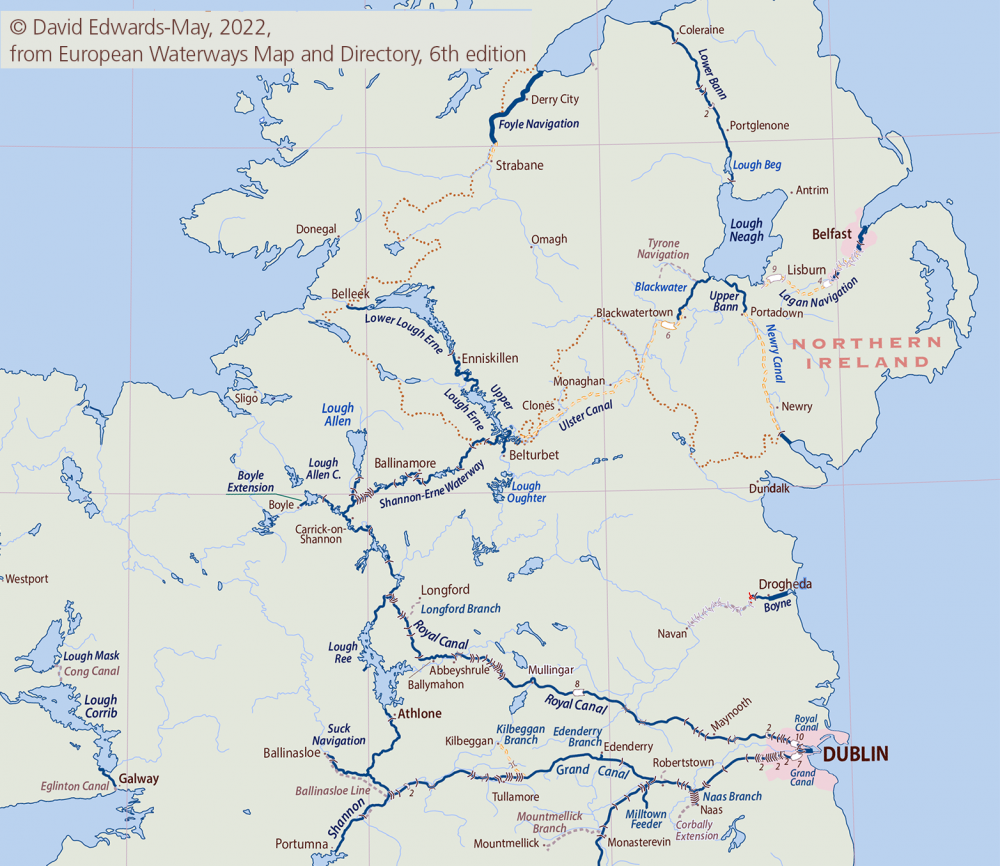Irish canals map (click to open)
Lagan Canal
- Boat length : 70’ or 21.95m
- Boat width : 16’ or 4.9m
The Lagan canal had a difficult birth. The intention was that it should transport coal from County Tyrone to Belfast to supply the city’s industry, and plans were drawn up to establish a 27 mile navigational link from Belfast to the shores of Lough Neagh. The initial section, opened in 1763, followed the existing river out to Lisburn but raising funds to continue work on the canalised section out to the Leogh proved challenging. In the end the government had to resort to levying an additional tax on alcohol and in 1782 they hired Richard Owen, who had worked on the Leeds Liverpool canal, to finish the job. The entire length was opened in 1794 and contained 27 locks. The canal was prone to flooding in bad weather, but there were also water supply problems because resources had to be shared with the local linen bleaching industry. Because of this unreliability, coal had to be imported from Belfast and distributed around the region when the original plan had been the reverse of this. After the First World War traffic dropped by 50% but during peacetime the Lagan continued to be used to move sand and gravel from the leogh to the capital to supply the ever growing need for construction. However, following the Second World War there was a collapse in traffic and the canal network was closed in 1958. Since 2008 proposals have been drawn up to reopen navigation to leisure traffic.
For boating enthusiasts, Titanic Belfast is a destination in its own right. Architecturally striking, this museum was constructed a hundred yards from where the legendary RMS Titanic was actually built and was opened in time to commemorate the 100th anniversary of her sinking. It has nine interactive galleries and a recreation of some of the cabins on board the original.
Shannon and Erne Canal
- Boat length : 79’ or 24m
- Boat width : 15’ or 4.5m
- Draft : 4’ or 1.2m
- Headroom : 10’5” or 3.2
The Shannon and Erne is a cross border canal linking the River Shannon in southern Ireland to the River Erne in the north. In its first incarnation it was the Ballinamore and Ballyconnell canal and it opened in 1853 at a cost of £273,992, almost three times its initial estimate. To say that it never really got off the ground would be an understatement. Between 1860 and 1869 only eight boats used it, generating tolls worth £18 – not a great return on the considerable investment involved, so it comes as no surprise that it was soon closed down. During the 1960s the pleasure boating industry began to flourish and the River Shannon became a popular destination for cruisers of all shapes and sizes. Inspired by this success, governments of the north and south agreed to undertake a flagship project and cooperate on the renovation and reopening of the old canal. The great moment came in 1994 with its re-launch as an attractive state-of-the-art waterway entirely geared to tourist traffic, with 16 locks all electro-hydraulically operated. Wildlife is now flourishing and you can see swans, otters and kingfishers along the pretty banks.
The Ariana Mining Experience is a day out with a difference. Only 20 minutes drive from Carrick on Shannon, one of the starting points for cruising the canal, Arigna charts the history of coal mining in the region from the 1700s until 1990 when the local pit was closed. As part of your visit you will enjoy an underground tour with authentic visual and sound effects which help to recreate a sense of what it was like to work underground all those years ago. In complete contrast, the area around the village of Leitrim is home to more than forty lakes and is the perfect place to enjoy a spot of fishing, making it a favourite amongst anglers of all levels of experience.
Ulster Canal
The Ulster canal was constructed between 1824 and 1842 over a 46 mile distance and containing 26 locks. It began Charlemont on the river Blackwater and finished near Waterbridge on the Finn river, crossing Counties Armagh, Tyrone and Fermanagh on the northern Irish side and County Monaghan south of the border. It was more or less doomed to failure because it the locks on the Ulster were a different gauge from ones elsewhere on Ireland’s waterways network which meant that boats were unable to transit smoothly from one to the other. The canal is notable for its contribution to the collapse of the Lagan Navigational Company who took it over in a bid to revive its fortunes. To no avail: the canal closed in 1931. The news isn’t all bad because Waterways Ireland is now working on a construction project to reopen the southern end of the canal so that it can be reconnected with the Shannon Erne and share its success as a magnet for boating tourism.
While you are in the area it is worth taking a visit to the Crom Estate in the south of County Fermanagh. This is owned by the National Trust and is a spectacular place for woodland walks filled with photogenic vistas. If you have kids in tow, they will be enchanted by Erica’s Fairy Forest, a verdant place full of magic created by the parents of Erica Ni Dreaghneain to commemorate her death in 2016 at the age of only six. In spite of her cancer, Erica believed in fairies until the very end.
British-Irish waterway regions – Northern | East Midlands | West Midlands | Welsh | Southern | Scottish | Irish
French waterway regions – North | North-East | North-Central | West | Centre | South-East | South | South-West

